Basmati Rice Recipe, How to Cook Basmati Rice
Updated: September 14, 2023, By Swasthi
Learning how to cook Basmati Rice perfectly every single time is a fundamental kitchen skill for all the Indian food lovers. With several simple steps, tons of tips and tricks, this post teaches you everything needed to cook perfect Basmati Rice that’s fluffy, non-sticky & not broken. This post covers 2 methods to cook basmati rice on stovetop in a pot – Absorption method and drain method. I also share how to cook basmati rice for different kinds of Biryani.
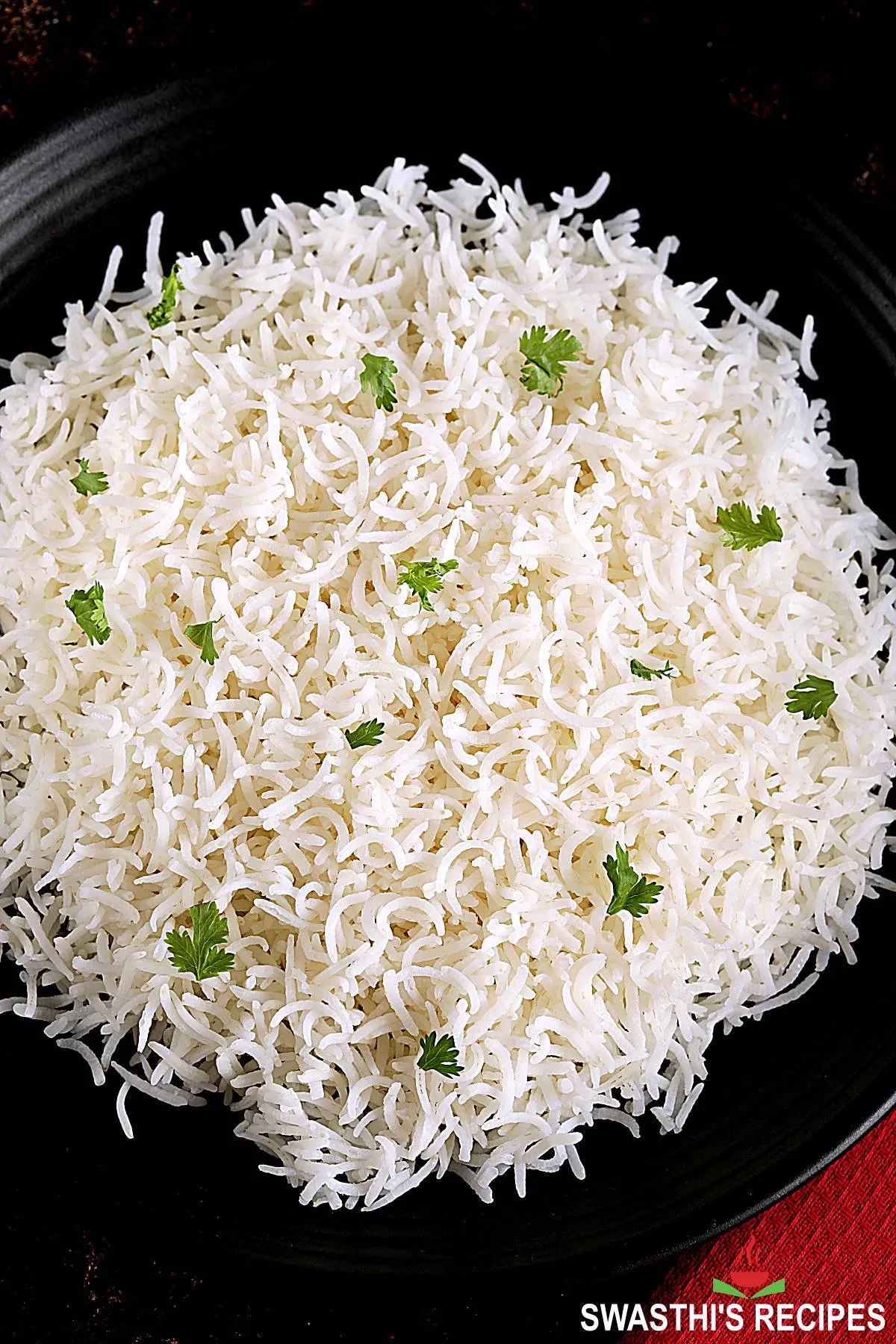
In the absorption method, rice is cooked with just enough water which is fully absorbed during the cooking. To adapt this method it is essential to know the correct ratio of rice:water.
Using the drain method, you cook the rice with excess/ surplus amount of water and drain it to a colander/ strainer exactly at the point when the rice is fully cooked. This method is great if you are a beginner or do not know what kind of basmati rice you are using.
With drain method you will never go wrong and will succeed every single time! Restaurants use this method and that’s the reason their rice is always the same – not broken, fluffy, non-sticky and soft enough but not mushy.
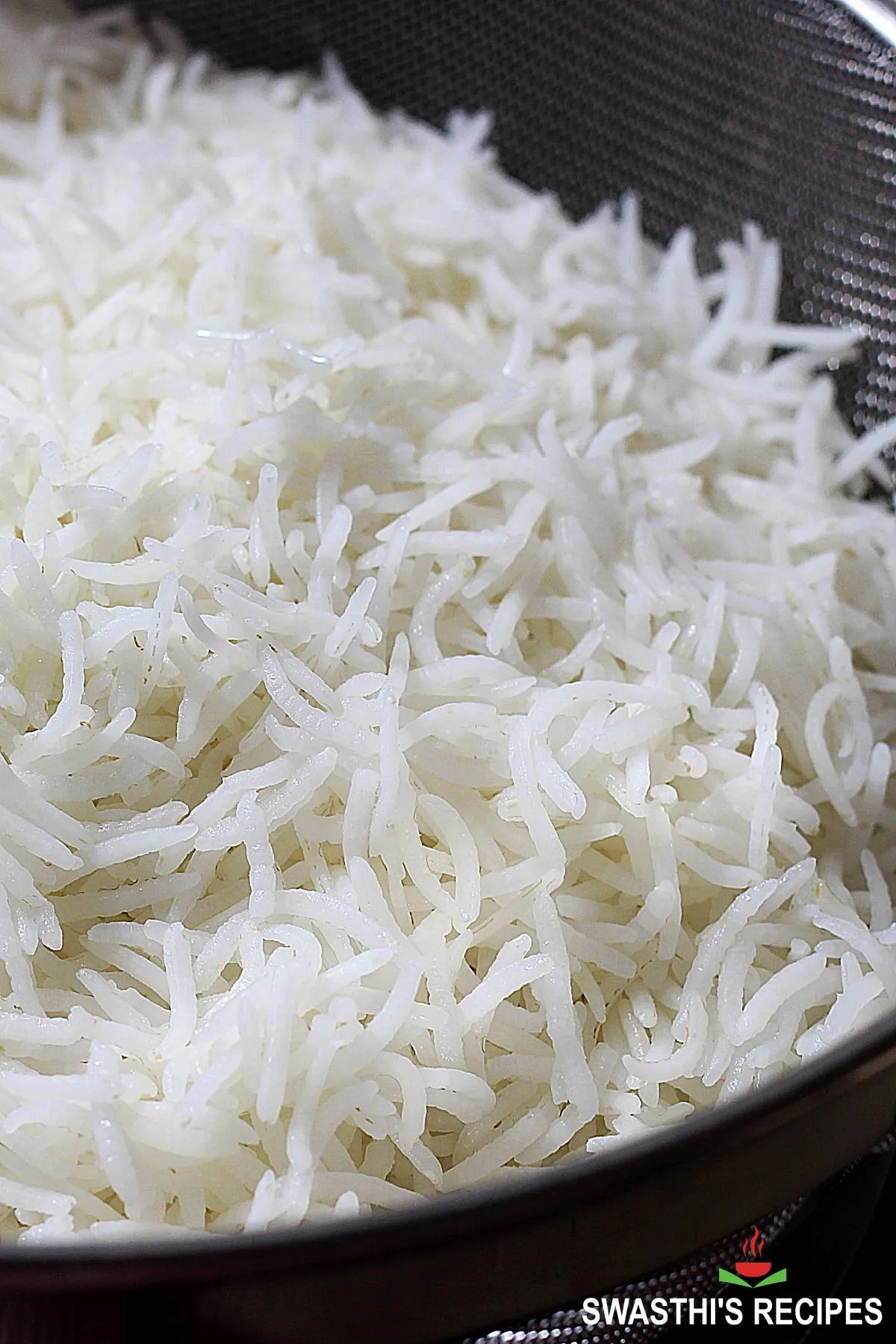
About Basmati Rice
Cooking basmati rice correctly is very crucial to making good biryani or to enjoy it with your favorite curry. The texture, aroma and taste of basmati rice or a Biryani largely depends on the quality of basmati rice used.
Choosing good quality basmati rice is essential if you want to enjoy aromatic and fluffy grains that are separate and not mushy. Aged basmati rice is the best choice!
High quality basmati rice is aged, meaning it was harvested at least a year ago and was stored properly to let the grains age naturally. Like wine, it gets better at aroma and texture as it ages. So high quality basmati is pricey when compared to the newly harvested grains.
Using good quality basmati is not enough, but it has to be cooked right to get the correct texture & retain the flavor. The techniques explained in this post are time-tested and have never failed me in my 2 decades of cooking experience.
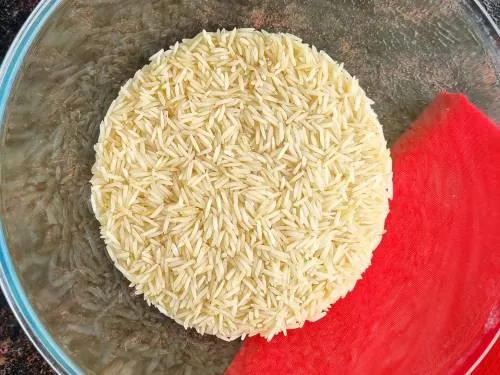
Photo Guide
How to Cook Basmati Rice (Stepwise Photos)
Absorption Method
1. Add 1 cup basmati rice to a bowl and rinse well thrice. During the first rinse, you will see the water is cloudy and white due to the excess starch.
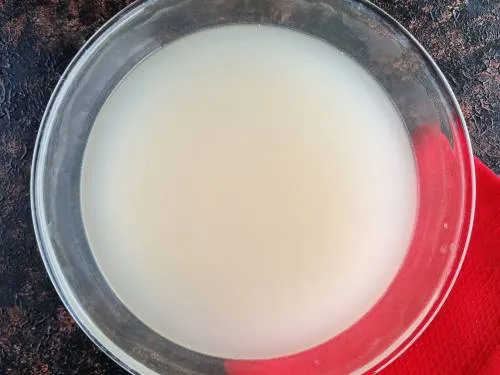
2. Drain the water and pour fresh water. The water looks clearer at this stage. Soak the rice for a minimum of 15 minutes. If you are using newly harvested rice, do not soak.
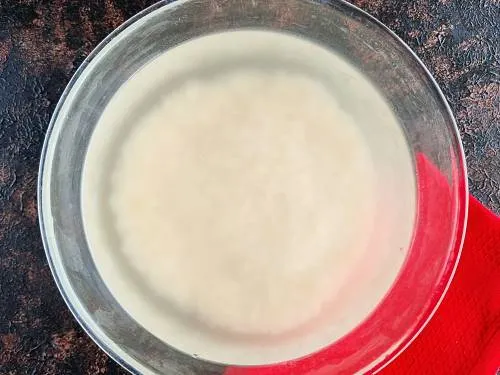
3. Pour water to a heavy bottom pot. If you want to add salt, whole spices, oil or ghee, you may add at this stage.
For aged basmati rice use 2 cups water and for newly harvested rice start with 1½ cups water.
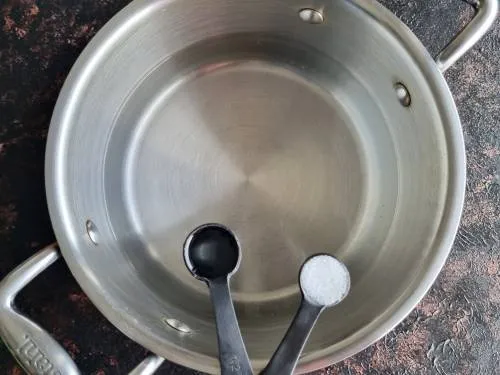
4. After 15 mins, drain to a colander/strainer and shake off gently to get rid of the excess water.
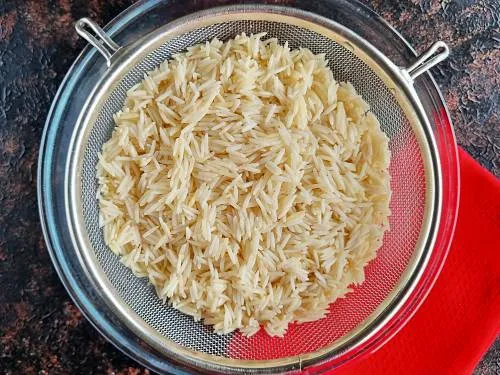
5. Bring the water to a rolling boil on a high heat.
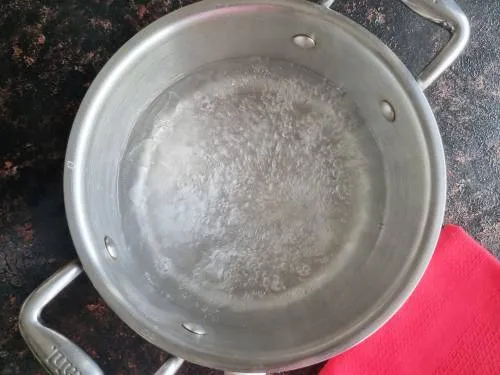
6. Add the drained rice and spread it with a little spoon.
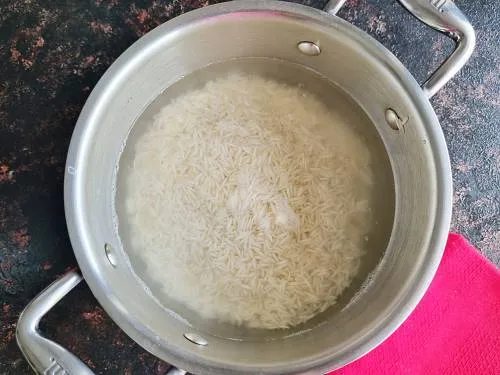
7. Increase the heat to high, to keep the rice boiling rapidly.
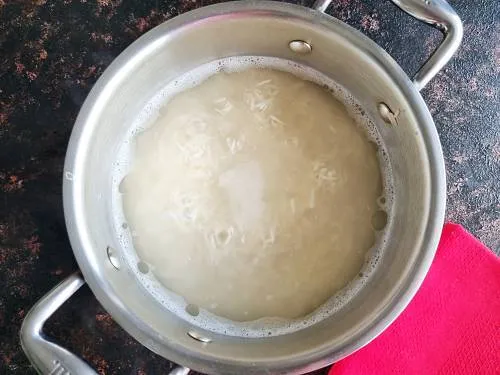
8. Reduce the heat to low and cook covered until the rice is al dente, slightly undercooked. This step should take you no longer than 10 to 11 minutes. Do not stir or mix at all during this stage of cooking. If you see the rice bubbling and frothing up, you may open the lid one to 2 times & cover back.
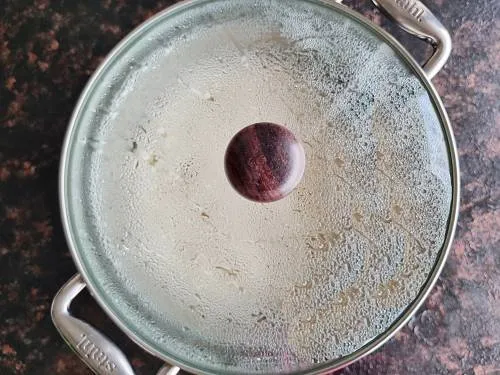
9. When the rice is almost cooked al dente, you will see little holes and the water is fully absorbed. If you find your rice, is undercooked and there is not enough water, add a few tbsps of hot water.
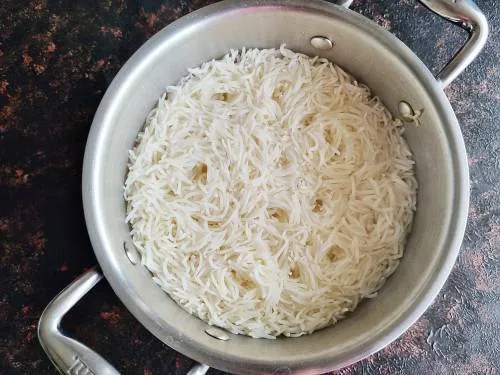
10. At this stage, check by inserting a rice paddle straight into the pot, from a side towards the bottom & look down. Ideally there should be no excess water at the bottom. (read troubleshooting tips below). Optionally, using the paddle, turn the rice from the bottom to the top only once to get the top layer rice down and bottom wet rice to the top. Level the rice on top. Do not over do this as the grains can break.
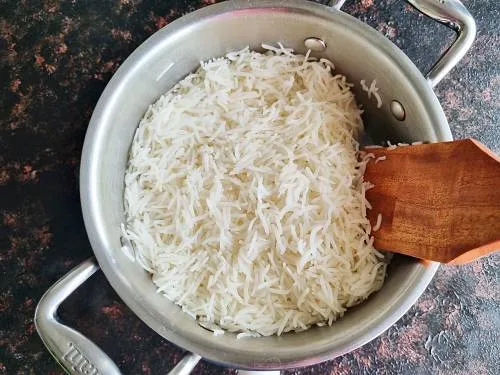
11. Cover the pot & turn off the stove. Let rest on the hot burner for 10 to 15 mins. Basmati rice will still be steaming in the residual heat. This helps the rice to turn fluffy and will cook completely.
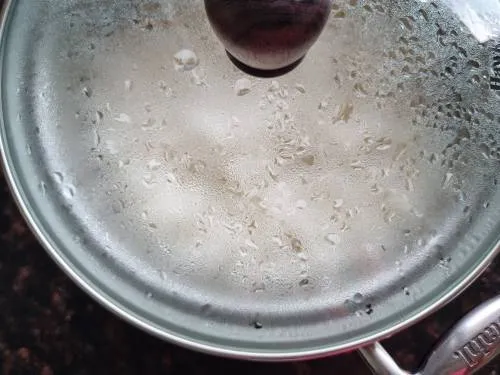
12. After resting, each grain should look like biryani rice grains – long, fluffy, non-sticky and not broken.
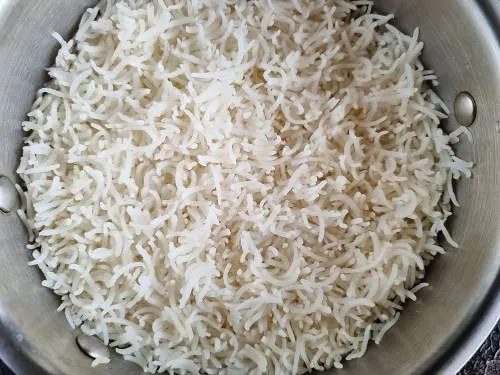
Use a rice paddle to serve the basmati rice with Dal tadka, Chickpea Curry, Butter Chicken or Tikka masala.
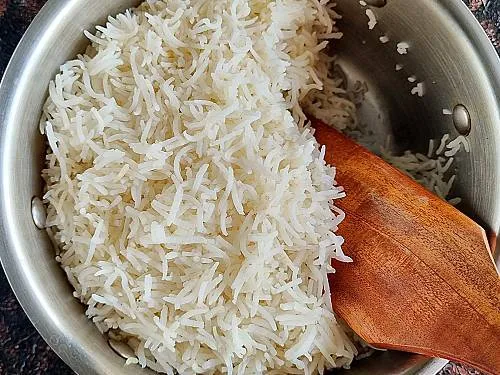
Troubleshooting Tip: If you use the correct amount of water you won’t be left with any excess water when the rice is al dente. But if you find little excess water, simply increase the heat to medium high and cook without lid for a few minutes to evaporate the water.
The other way is to drain the rice to a colander placed inside the sink or over a large bowl. Add the rice back to the hot pot & cover it.
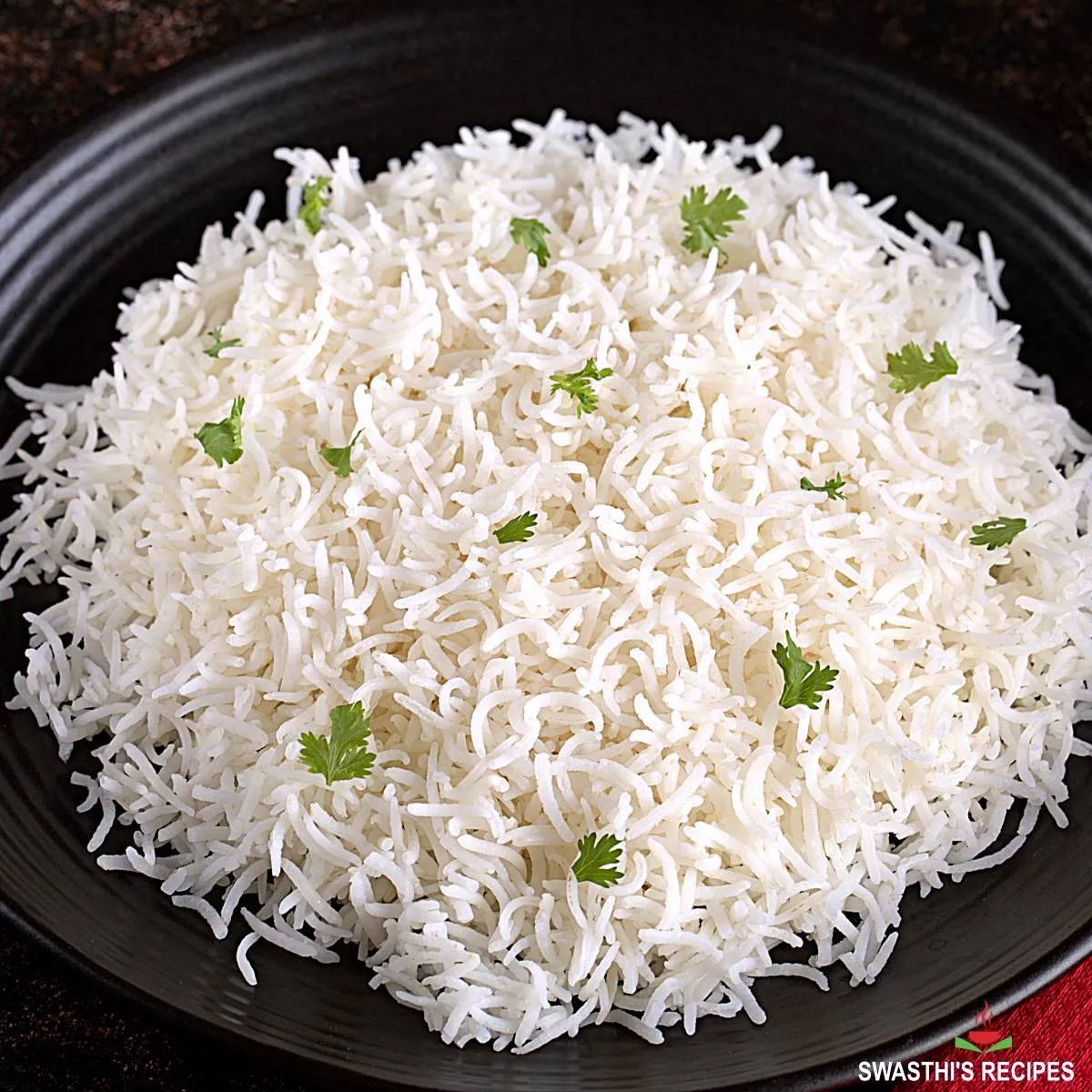
Photo Guide
How to cook Biryani Basmati Rice (Stepwise Photos)
Drain Method
1. Always choose premium quality basmati rice that is aged and has been stored in good condition. Wash it well a few times in ample amount of water. Soak for at least 30 to 40 minutes again in apmple amount of water depending on the kind and brand. Some kinds of rice need about 60 minutes plus for the grain to absorb water. This helps the grain to expand well while cooking. Drain the rice.
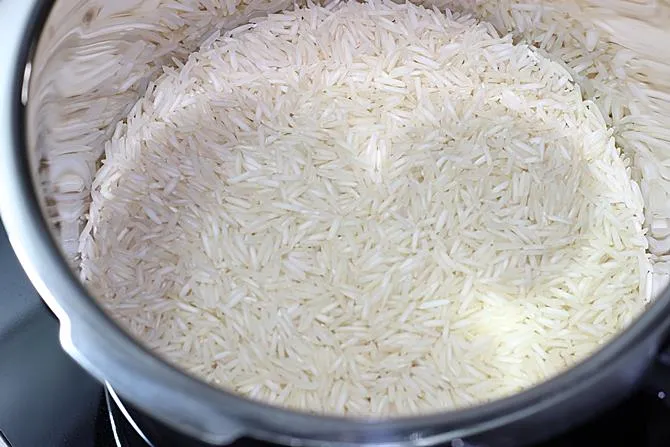
2. Bring water to a boil in a large pot. Usually for 1 cup rice, any where from 4 cups to 5 cups can be used. If you are not using premium quality rice, you should be using up to 5 cups water to get rid of starch completely. Add salt as needed. Taste the water, it has to be slightly salty.
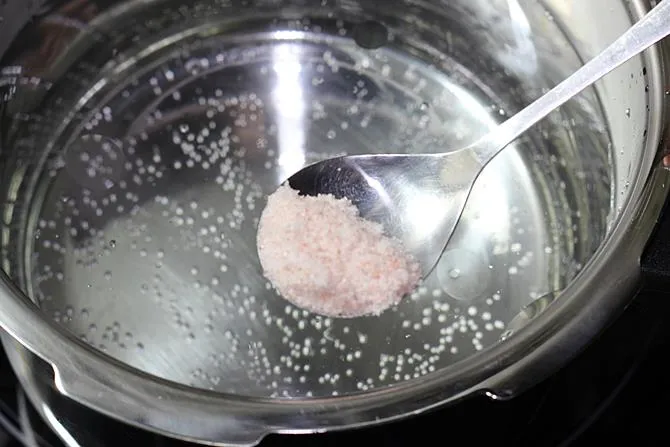
3. Add in the spices along with 1 tsp to 1 tbsp oil again depending on the quality of rice. Spice like bay leaf, star anise, shahi jeera, cinnamon, cloves and mace can be used. All the spices are optional, but most commonly a bay leaf and some shahi jeera does the job of infusing flavor to the rice. If you do not like to get the whole spices in your biryani then you can also tie them in a muslin cloth and add it to the water. Discard it when the rice is drained.
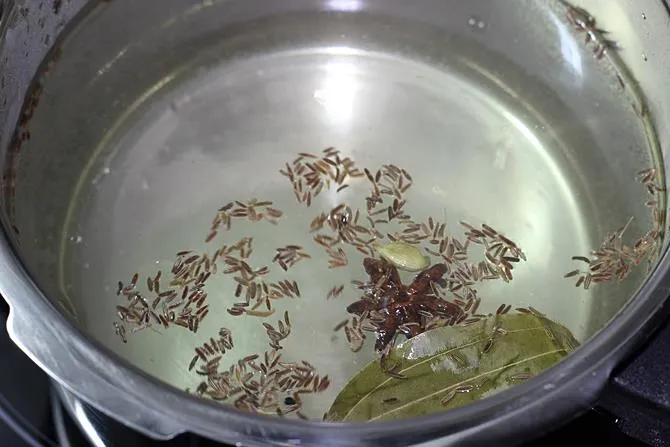
4. When the water comes to a boil, allow to boil rapidly. Add the drained rice. Do not stir too much since the rice is soaked for long time it tends to break.
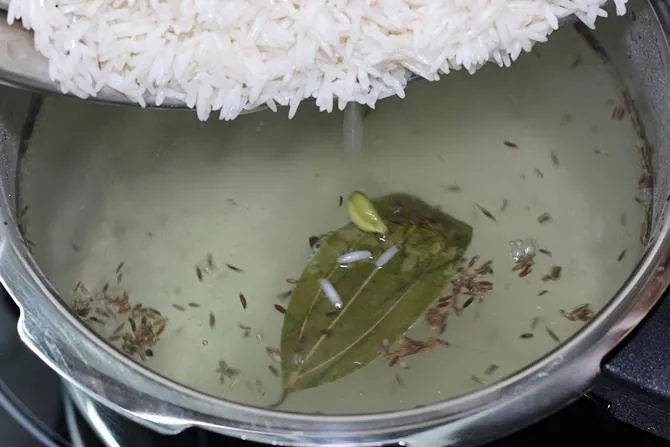
When to drain basmati rice
5. When to drain the rice depends on what kind of biriyani you are making.
If making kacchi mutton biriyani, basmati rice has to be half cooked i.e 50% to 60%. The rice expands completely by then, but has to be cooked further which is done during the dum process. Usually yakhni or rice cooked water is also added in small quantity to generate the steam since mutton takes longer time to cook.
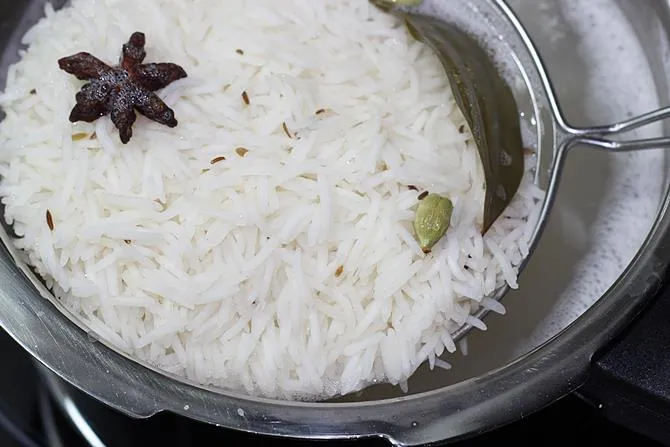
If making kacchi chicken biryani, your rice has to be under cooked or 75% cooked and not al dente. Since the marinade for kacchi biryani has more moisture than the pakki biryani, it has to be under cooked. 25% will be cooked when the meat is dum cooked due to dum released during the process. But how do you identify 75% cooked basmati rice? When you bite into the rice, you will feel the slight rawness in the rice.
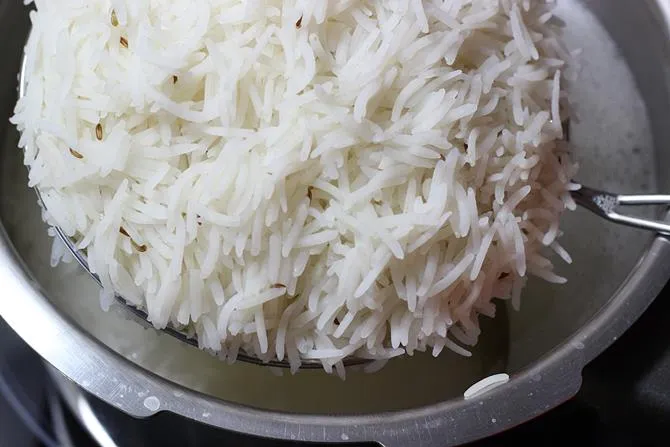
Cooking basmati rice for layered biryani
If making pakki biryani – veg biryani, chicken biryani, mutton biryani – Basmati rice has to be 90% cooked i.e cooked to al dente. The rice doesn’t get cooked much in this kind of biriyani since it is dum cooked for short time. Basmati rice turns slightly tender due to the short period of dum/steam.
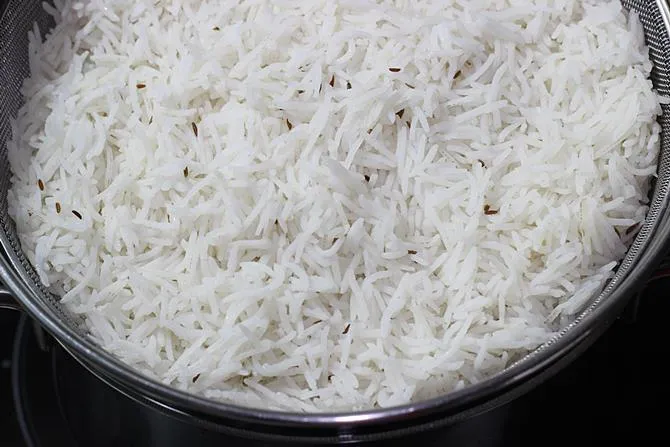
If making only layered biryani – like egg, prawns or fish biriyani – rice has to be cooked to 90 to 100% based on the moisture and the time taken for dum cooking. Rice must be grainy but not mushy. In this kind of biriyani, the dum process does not release any moisture but instead only infuses the flavors.
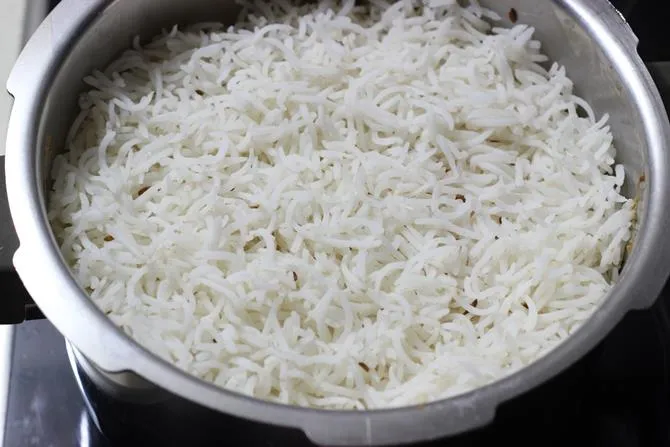
It is always best to follow cooking basmati rice for making biriyani from the biryani recipe you choose to try and not follow a generic one.
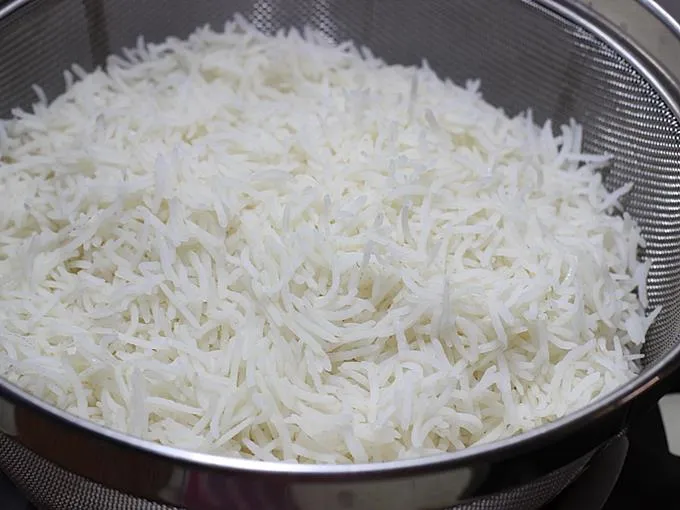
Pro Tips
Rinse the Rice: It is essential to rinse the rice before cooking to get rid of the excess surface starch which can easily make the rice sticky and lumpy.
Rinsing also washes away some of the preservatives used during storage.
Soak the Rice: High quality rice needs proper soaking and this helps in retaining the aroma and helps the grains expand to the fullest, upon cooking. You will get longer, fluffier and more aromatic rice grains.
Related Indian Rice Recipes,
Chicken biryani
Mutton biryani
Veg biryani
Related Recipes
Recipe Card
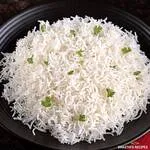
Basmati Rice Recipe, How to Cook Basmati Rice
For best results follow the step-by-step photos above the recipe card
Ingredients (US cup = 240ml )
- 1 cup aged basmati rice
- 2 cups water reduce by ½ cup if using new rice
- ½ teaspoon oil or ghee (optional)
- ¼ to ½ teaspoon salt (optional)
Instructions
- Add basmati rice to a bowl and rinse thrice. Drain the water.
- Soak the rice for a minimum of 15 minutes and drain to a colander/ strainer. Shake off gently to get rid of excess water. Avoid soaking if using new harvested rice.
- Pour water to a heavy bottom pot and add salt, ghee or oil (optional). If you want you may add whole spices like star anise, cinnamon, cloves, cardamoms and cumin seeds.
- Bring the water to a rolling boil on a high heat and then add the drained rice. You will see the temperature falls after adding rice, so let the water come back to a rolling boil on a high heat.
Basmati Rice in absorption method
- Reduce the heat to lowest and cover the pot. Cook till all of the water is absorbed, for 10 to 11 minutes.
- Do not stir while the rice is cooking. If you see the rice bubbling and frothing up, simply open the lid 1 to 2 times before it overflows and cover back.
- Insert a rice paddle to the bottom of the pot to check if all of the water is absorbed. Turn off when the water is completely absorbed and the rice is cooked through.
- Cover and let rest for 10 to 15 minutes on the hot burner (stove turned off).
How to cook Basmati rice in drain method
- Reduce the heat to medium or medium-high so the water does not over-flow. But it is important to keep the water boiling constantly until the rice is cooked through.
- Place a large pot under the colander or simply place your colander in the clean kitchen sink. When the rice is cooked al dente drain to the colander.
- Transfer the rice back to the pot and cover it immediately. Let rest on the hot burner (stove turned off) for 5 to 7 mins.
- Your fluffy and perfectly cooked basmati rice is ready.
Stir-fried Method
- Heat ghee in a wide pot and add the drained rice (completely no water). Increase the heat to high and stir fry the rice occasionally for 2 to 3 mins.
- Pour water and bring it to a rolling boil. Reduce the heat and cover the pot. Let cook until all of the water is absorbed.
- You have the fulffy basmati rice under 10 minutes.
NUTRITION INFO (estimation only)
© Swasthi’s Recipes
About Swasthi
I’m Swasthi Shreekanth, the recipe developer, food photographer & food writer behind Swasthi’s Recipes. My aim is to help you cook great Indian food with my time-tested recipes. After 2 decades of experience in practical Indian cooking I started this blog to help people cook better & more often at home. Whether you are a novice or an experienced cook I am sure Swasthi’s Recipes will assist you to enhance your cooking skills. More about me
Follow Swasthi’s Recipes

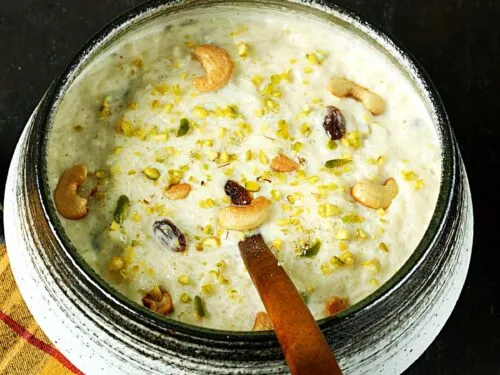
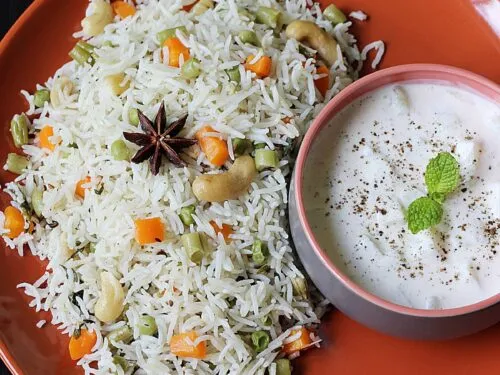
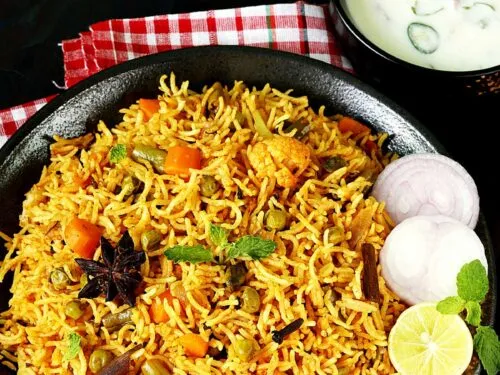
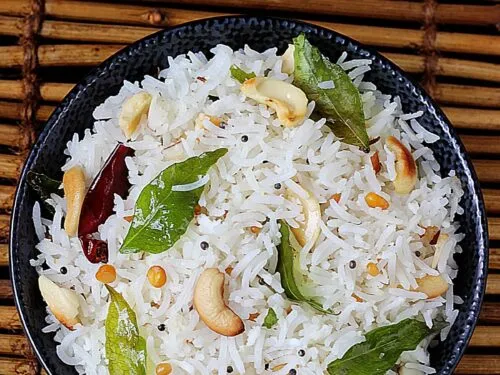
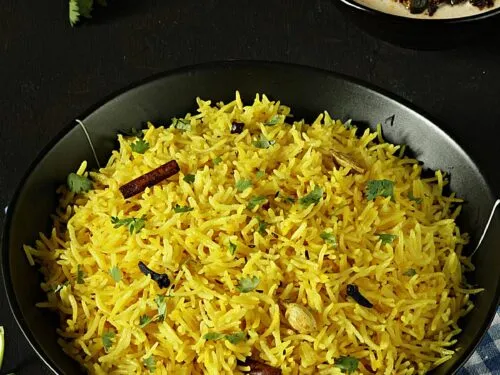
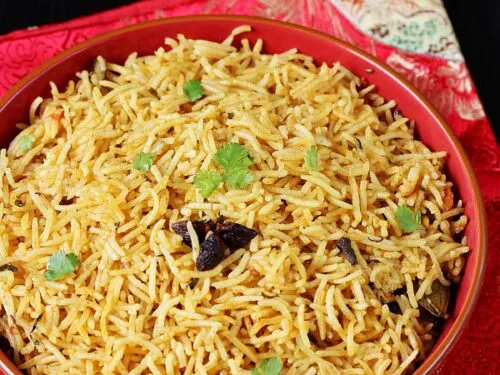
Comments
For the drain method, how many minutes is it to al dente? I know it depends on the basmati rice brand, but if you could give an estimate?
Hi April,
It largely depends on the intensity of heat, the kind of pot and the temperature in your kitchen. For premium quality soaked aged rice, it takes me 7 to 8 mins, from the time the rice comes to a boil. Hope this helps
hello,,
i ask too many questions .. which cooker is more better in cooking rice with spices .. the manual gas cooker or the electric one ..as i boil it on the regular and commercial basis …??
Hello Rahul,
No problem! Parboiling rice for biryani – If you are parboiling rice for biryani, it is best to cook in a open pot. This kind of rice needs attention (cooking on high heat) and it is easier to drain fast else your rice can get waterlogged. If the rice gets waterlogged, after dum process the texture is like soaked rice rather than steamed rice.
Plain or flavored rice – If you are cooking regular rice or flavored like jeera rice etc, any electric cooker with no pressure is best if you are making in larger quantities (more than 2 to 3 cups). Pressure cookers can easily make the rice clumpy and overcooked.
Pressure cooker (stovetop/gas or electric like instant pot) is best if you are cooking less than 2 to 3 cups. If you are okay with mushy rice then they work well. You can achieve best results (less mushy) by venting out some of the steam after turning off the stove. This can be dangerous if you are making more than 3 cups because it is unsafe to vent out so much steam at one time.
If you are using electric cooker, the non-stick coating can wear out faster due to spices (too many scratches). So temper them separately and add to the cooker.
Hope this helps
i got it but still confused .. as i will be using your chicken dum biryani (restuarant style – recipe -2 ), where rice needs to be cooked aalongwith whole spices .. as i am gonna use for the commercial purpose,,, either i will cook plain rice in stovetop POT in a bulk quantity and then for each biryani preparation ..will boil spices in a sauce pan and take out the portion of cooked rice for particular 1 biryani portion and mix boiled spices and warm it in a electric vessel..this is 1 method …
or for each biryani small portion of rice i have to cook it in a gas pressure cooker alongwith spices ( seperately cooked rice for every portion of biryani).. what will you suggest… as i dont want to ruin the ratio of whole spices … ??
I feel the second method is very tedious and my experiences with pressure cooking basmati rice (when made for biryani) is not great. Pressure cooker acts different during seasons – ex- winter, summer and monsoon. 1 whistle during summer may work and that may not during winter or monsoon. If you know how to fine tune the timings it’s alright. This is my experience with basmati rice but may be different for you. Basmati cooked in a pressure cooker won’t be great for biryani. When cooked in plenty of water on the stove, it expands to the fullest and looks much more in quantity.
Ex: If I am making 50 servings of biryani with 8.5 kg chicken, I would cook the chicken gravy for the biryani at one go. But batch cook rice on stove according to orders. Weigh or measure the chicken gravy and rice required per serving. This is best for a commercial purpose.
ok got it… to conclude it finally i will make some changes in the recipe-2, i will cook the plain rice in an open pot on a one go in a bulk and the whole spices will use during the laying of the biryani ..as i use separate clay pots with lid for dum steaming process ex. if i want to make 10 portions of biryani i put 10 clay pots sealed lid with aata in an electric oven.. so i can pour boiled spices alongthwith infused water over the cooked rice separately in every clay pot.. so 15 minutes of dum steaming is sufficent to spread the aroma and the flavour of spices in that .. thats the best way i think to switch the whole spices .. without altering the ratio.. right …
Yes it seems right and you can easily fine tune after trying out 2 to 3 batches. Good Luck!
thank you !!
I have a question.
They say you can cook rice for biryani in rice cooker.
I find it a bit odd. As I went through so many articles about cooking rice for biryani. And they woudl first boil the water adn then put the soaked rice into it. Means rice is added to super heated water.. In rice cooker, it will be like putting rice in ok ok heated water .. or say water and rice heats up simultaneously.
I really think I can bring Liberians to know Indian food.
The absolute fail proof method to cook basmati rice is to boil and strain like shown in the photos. I cooked 3 cups of sella basmati this way and it turned out good. Stirred in 3 tablespoons of ghee and covered it. It smells amazing and tasted fantastic with your palak paneer.
Thank you. Love the details you mention about kacchi and pakki biryani rice. Bookmarking it for reference.
Your recipe is so well written and I am excited to try it soon. I will be making basmati rice, dal fry and palak paneer (all your recipes) for a family dinner. I find cooking basmati rice perfectly (like seen in the pictures) is a difficult task for me. Do you have a favorite brand of basmati rice that won’t get mushy? Please reply…
Hi Olivia,
Thank you. Look for aged basmati rice. Any brand works the same way. I use Dawat extra long biryani basmati. Hope you all enjoy the dishes.
I am so happy to discover you. I think you are amazing and I love your recipes. I am new at cooking Indian food and I must become familiar with your methods and spices and they are used. I wish you could advise me which is the best Basmatti Rice to use since there are so many brands that I am not familiar with. Thank you for your reply. I am Millie Guzman and I live in Florida, USA
Glad to know you Millie! Thank you so much for the kind words. Royal, Kohinoor, dawat and lal quilla are some popular brands. Again each brand has many different kinds like extra long, super gold, extra fragrant etc. Just look for something that is labelled as aged rice or naturally aged. This kind of rice is best in terms of flavor and texture. Hope this helps!
Your recipes are amazing and so much better than what I’ve experienced in restaurants! I don’t know why, but in my old age, I’ve become really rubbish with rice. Followed this but, in the end , found the rice was still too starchy. At LEAST it was edible! Rinsed with boiled water and it was perfect. Thank you!
Hi Claire,
Thank you for the kind words. There are many kinds of basmati rice. Aged, newly harvested and some are the hybrid varieties which are more starchy. Some brands recommend rinsing the cooked rice with boiled/warm water like the way you did. However that works only with certain kind of basmati rice. You can also try the draining method. Remove the rice from the surplus hot water using a spider. It is easier than draining. Hope this helps
How much water would you use for extra long basmati in IP? Do you soak for 15 mins and is 5 mins right for this kind of rice?
Use 1¼ cup for 1 cup rice. Yes I soak for minimum 15 mins and pressure cook for 5 mins and release the pressure after 2 mins. For more firmer rice release immediately. If you double the rice, release immediately
I like the stir fried basmati rice. I had some betel leaves to use up. Added them as the rice was boiling. Turned out wonderful.
Nice to know Avani. Thank you
I have made so many of your recipes and love this page a lot. I love every detail in this post on how to cook basmati rice perfectly. I have been using it to make plain and flavored rice. Thank you
Thank you Ravena for the kind words.
I tested this recipe with a cup of rice and the pot recipe works great. But I’m not sure if I should use 8 cups water for 4 cups basmati rice. Also do you think I can cook this in a rice cooker or a instant pot? Any advice is appreciated
4 cups rice is a lot, so you should be using a wider pot (at least 28 cm). To start off I would use 7.5 cups, reducing half cup water and then add more hot water during the finishing stage only if it is undercooked. You may not need that half cup water if the steam is trapped well during cooking.
I made a batch of basmati rice with some ghee and whole spices added to it. It smells amazing! Thank you
Glad you like it Maria.
Hi Swasthi,
Thank you for the lovely recipes. I’m learning to cook Indian food. I made your dal tadka and aloo gobi and the results were outstanding. Is there a special name for the aged basmati rice? ..because I have never come across that in the Asian markets.
Hi Annie,
Glad the recipes helped. Aged basmati rice is also labelled as Biryani Basmati rice. Look for that in the Indian stores. Hope this helps
I was following your recipe to make basmati rice from a very long time. However I’m unable to find the stir fry method. Would you mind adding that back?
Yes sure I can.
The drain method worked out well. I made 3 cups of basmati rice and it was great. I could never cook it so well before. Next time going to make it with ghee and whole spices.
Glad the recipe worked for you Nicole. Thank you!
I love how you teach us with step by step photos. This is was my first try to cook basmati rice and it turned out so good. Served it with your green dal recipe. Thank you.
Wow basmati with green dal sounds yummy! I too make it often. Happy to know June. Thank you so much
Thank you. This post is really helpful
Glad to know Meera. Thank you
Hi, nice chicken biryani recipe.
Which brand basmati rice r u using for biryani?
Yummy recipe
Sorry Suguna I forgot to reply you.
I use lalquilla old malai basmati. Thanks , do try it
Try with Royal Chef Secret basmati rice
Hi, did you use black salt or pink himalayan salt?
You can use regular salt too. I used pink salt
Salt is salt, NaCl sodium chloride the pink colour comes ONLY from potassium manganese iron and zinc. The exact pinkness depends on the mix, that is why not all grains are the same color.
EXCEPT things labeled ‘sea salt’ ‘salt flakes’ or ‘mountain salt’ etc DO NOT have iodine added so they are not ‘iodised’ this will cause a child’s brain to not develop and the body grows small as well but that’s extreme cases. Regular cases of iodine deficiency from birth to 20 ish years are often diagnosed as heavy metal poisoning from lead or whatever as the mild lack of brain development makes the kids stupid just like lead poisoning. I saw a tv show on it china identified iodine deficiency as the major cause of rural high terrain living peoples’ ‘lack of brain development’ they were stupid. They only ate the mountain mined salt and the locals could mine it themselves so obviously didn’t iodise it which is against the law in China.
Thanks for sharing that!